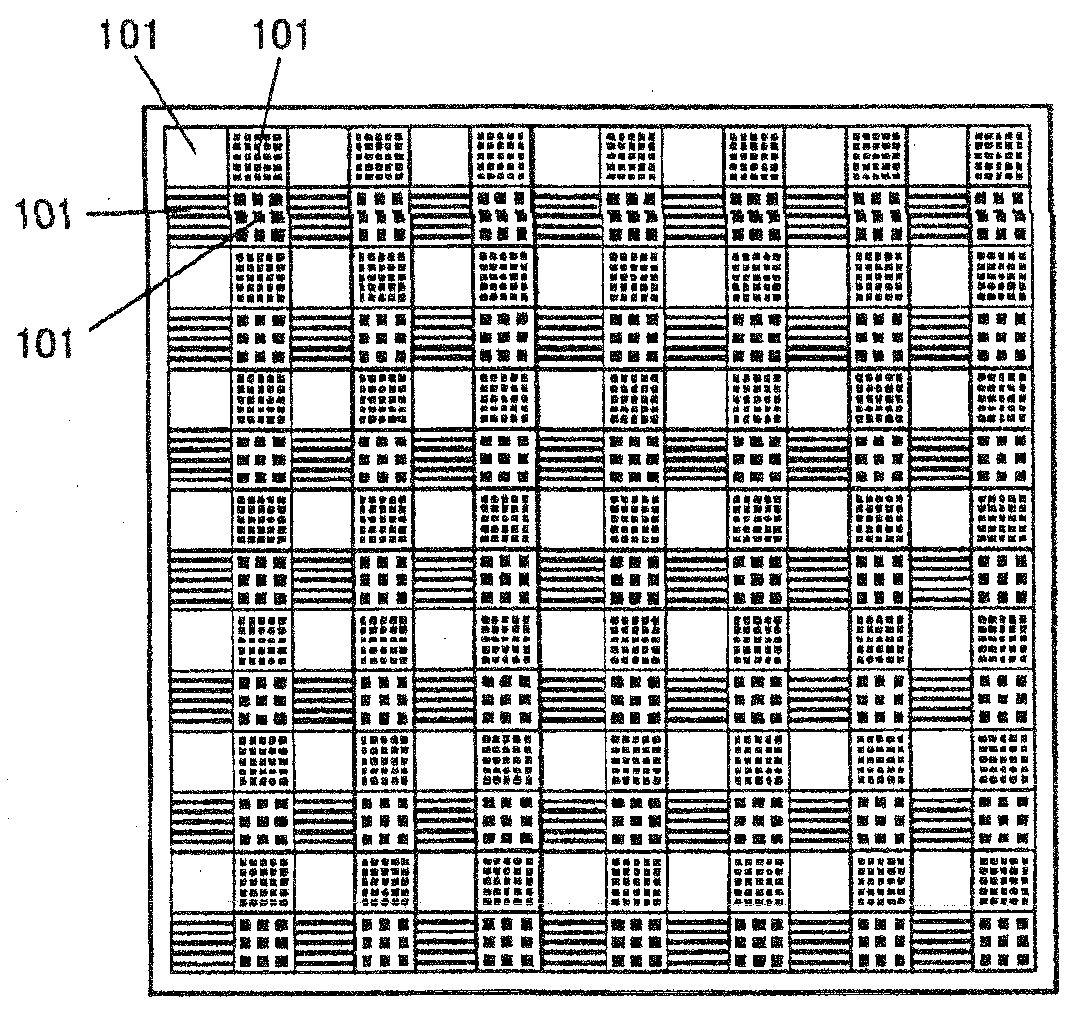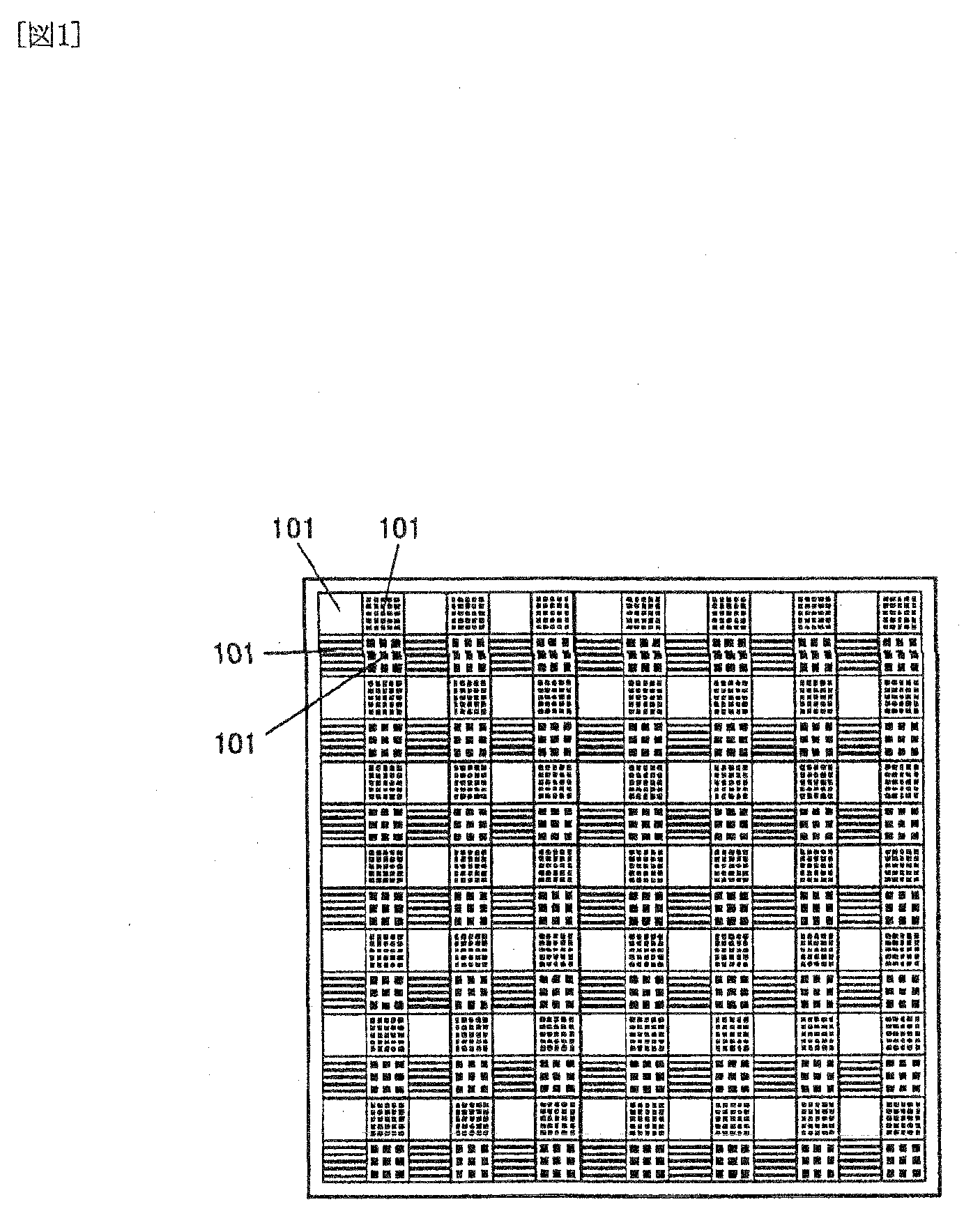Wavelength division image measuring device
a wavelength division and image technology, applied in the direction of optical radiation measurement, interferometric spectrometry, instruments, etc., can solve the problems of difficult to realize very sharp wavelength transmission characteristics, difficult to provide ink or resist type color filters with sharp wavelength selection characteristics, etc., to achieve easy integration, increase the number of wavelengths, and sharp selectivity
- Summary
- Abstract
- Description
- Claims
- Application Information
AI Technical Summary
Benefits of technology
Problems solved by technology
Method used
Image
Examples
first embodiment
[0109]FIG. 4 is a diagram showing one embodiment of the present invention. An embodiment using edge filter characteristics of the photonic crystal in a visible wavelength band is illustrated here. A mask layer composed of 200 nm thick Cr is formed on a quartz substrate 401 by a sputtering method to then apply a photoresist thereon. Four lattice shapes are drawn thereon by a direct lithography using an electron beam. Namely, squares with the lattice spaces of 420 nm in a region 402, 440 nm in a region 403, 460 nm in a region 404, and 480 nm in a region 405 are formed in a square lattice arrangement manner. Areas of respective regions are set to squares of 5 micrometers on a side. Subsequently, the mask of chromium (Cr) is removed by RIE (reactive ion etching) after developing the photoresist to then transfer the pattern to the quartz substrate. An etching depth of the quartz substrate is set at 100 nm.
[0110]Subsequently, after forming a transition layer 406 composed of a quartz for c...
second embodiment
[0113]A second embodiment of the present invention is shown in FIG. 9. The present embodiment illustrates a method for using narrow-band wavelength selection characteristics of the photonic crystal. In this embodiment, the lattice shape of a substrate and its production method, and the method of forming a multilayer film by the self-cloning method are the same as those of the first embodiment, but the in-plane lattice period and the film constitution of the multilayer film are different therefrom. Namely, four regions 901, 902, 903, and 904 whose in-plane lattice constants are 200 nm, 250 nm, 300 nm, and 350 nm, respectively, are formed as the element regions of the filter. In the film thickness direction, a Ta2O5 layer 906 of 95.2 nm thickness and an SiO2 layer 907 of 133.3 nm thickness are alternately laid up to a total of 20 layers on a quartz substrate 905, and a Ta2O5 layer 908 of 133.3 nm thickness is subsequently laid as a cavity layer. Subsequently, a SiO2 layer of 133.3 nm ...
third embodiment
[0115]FIG. 11 is a diagram showing a third embodiment of the present invention. Namely, this embodiment is a combination of a filter 1101 in the aforementioned first or second embodiment (this is referred to as a “first filter” only in this embodiment) and a second wavelength filter 1102 which is not arrayed, namely, having uniform wavelength characteristics across a whole incident plane. An example of wavelength characteristics of a second filter is shown in FIG. 12. Since this has a uniform structure across the whole area, special ideas are not required for designing and manufacturing it. When the region 404 of the filter shown in the first embodiment is used as the first filter, combined transmission characteristics of both filters will be shown in FIG. 13. Namely, when the measurement light with the wide wavelength width ranging from 700 nm to 950 nm of wavelength is entered, wavelength components equal to or less than 770 nm of wavelength are also transmitted in the first embod...
PUM
 Login to View More
Login to View More Abstract
Description
Claims
Application Information
 Login to View More
Login to View More - R&D
- Intellectual Property
- Life Sciences
- Materials
- Tech Scout
- Unparalleled Data Quality
- Higher Quality Content
- 60% Fewer Hallucinations
Browse by: Latest US Patents, China's latest patents, Technical Efficacy Thesaurus, Application Domain, Technology Topic, Popular Technical Reports.
© 2025 PatSnap. All rights reserved.Legal|Privacy policy|Modern Slavery Act Transparency Statement|Sitemap|About US| Contact US: help@patsnap.com



